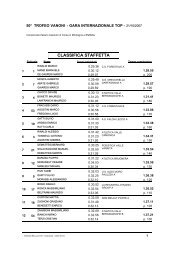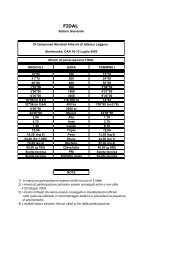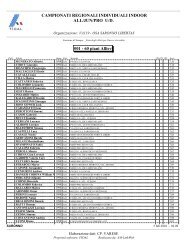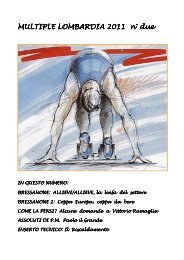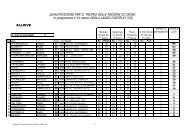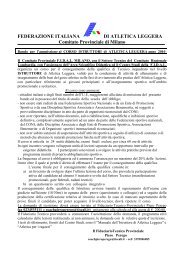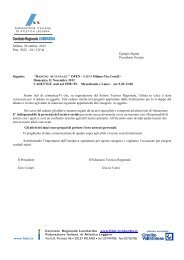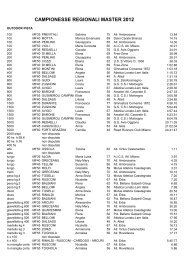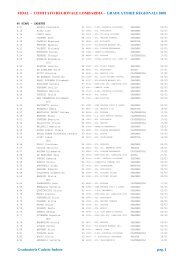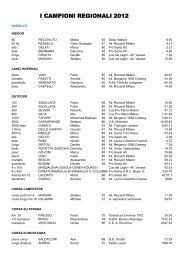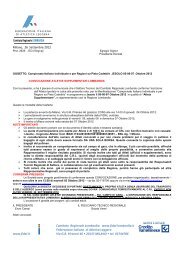UKA/London Marathon Altitude Programme ... - Fidal Lombardia
UKA/London Marathon Altitude Programme ... - Fidal Lombardia
UKA/London Marathon Altitude Programme ... - Fidal Lombardia
Create successful ePaper yourself
Turn your PDF publications into a flip-book with our unique Google optimized e-Paper software.
“We’re offering a fully managed and supported programme with<br />
medical, physiological and nutritional assistance and we’re giving<br />
our athletes the opportunity to benefit from an exceptional training<br />
environment surrounded by world class athletes.<br />
“It doesn’t have to be fancy – the great thing about Kenya, for<br />
example, are the miles and miles of dirt trails; there’s literally<br />
nothing else to do up there but train, which is exactly what they<br />
need to maintain their focus.”<br />
The training environment in Iten – as well as in Font Romeu - is<br />
unprecedented for endurance athletes.<br />
“I loved the experience of Iten,” says Lee Merrien. “It’s a fantastic<br />
environment in all aspects of running life. I had a little bit of an<br />
idea what to expect as friends had been out there already, but I<br />
really liked it – and will be going back to put the finishing touches<br />
to my VLM preparations.”<br />
In addition to the two core camps which run for four to five<br />
weeks in spring (April/May) and autumn/winter (Oct/Nov), smaller<br />
dedicated camps of three to four weeks, as well as Aviva holding/<br />
preparation camps for athletes selected for the annual major<br />
championships will be operational going forward.<br />
This enables a rotational model of exposure to altitude which<br />
is central to the success of the altitude programme and involves<br />
approximately three to six week blocks at high altitude and four<br />
to six week blocks at sea level; this periodisation altitude model<br />
prolongs the time athletes spend at altitude so that the potential<br />
benefits can be maximised over a twelve month period. RF<br />
<strong>UKA</strong>/<strong>London</strong> MARAthon (LM) ALtItUde tRAInIng CAMP AnnUAL RePoRt | 23<br />
83<br />
LEE MERRIEN<br />
DISCUSSES HIS<br />
ITEN EXPERIENCE<br />
“Generally, I will use a<br />
training camp in the buildup<br />
to an important race.<br />
This year, for example, I’ve<br />
used a couple of camps in<br />
preparation for the Virgin<br />
<strong>London</strong> <strong>Marathon</strong> and last<br />
year I used Font Romeu<br />
before the Commonwealth<br />
Games and the European<br />
Championships. The main<br />
benefit for me is that you<br />
can focus purely on training<br />
and get the rest you need –<br />
without any distractions. It<br />
means you can eat and sleep<br />
like an athlete, perhaps better<br />
than you can in your own<br />
home environment.<br />
“Most days, we’d run as a<br />
group at 7am, although we<br />
also had the opportunity to<br />
run with the Kenyans, and<br />
their runs would start at<br />
6.15am.We would join the<br />
Kenyans on what were their<br />
‘easy easy’ runs. These would<br />
be about 70-80 minutes and<br />
at an average of no faster than<br />
6.30 min/miling, but bearing<br />
in mind the first mile is run at<br />
9 minutes, it gives you an idea<br />
of how much it picks up. It’s a<br />
fantastic time to run as the sun<br />
comes up.We’d run in almost<br />
complete silence: the Kenyans<br />
are incredibly focused.”<br />
As you might expect, with<br />
everything concentrated on<br />
running, the distractions of<br />
everyday life are few and far<br />
between.“We all got very<br />
good at table tennis,” says Lee.<br />
“We did have Internet access,<br />
but the connection wasn’t<br />
great. And we played a lot of<br />
board games – something I<br />
hadn't done for ages.You’re<br />
happy to be relaxing and<br />
doing things like having an<br />
afternoon nap: you just tend<br />
to fall into the Kenyan way of<br />
life, which generally means<br />
that everything’s done at its<br />
own pace.”<br />
A second training session<br />
would then take place later<br />
in the day. Steady runs would<br />
head out at about 5pm, or, if it<br />
had been an interval session<br />
mid-morning, then the second<br />
run would be about half an<br />
hour later.“We’d run twice a<br />
day, every day, and we’d also<br />
do weights,” says Lee.“I was<br />
averaging around 120 miles a<br />
week, but with the altitude, it<br />
be would be worth a bit more<br />
in the UK.”<br />
And how has it helped<br />
his preparation? “If<br />
everything goes well, I’d be<br />
looking at trying to get some<br />
qualifying times at <strong>London</strong> for<br />
the World Championships,”<br />
says Lee.“Training is going<br />
well: if I don’t run faster than<br />
last year, than something<br />
will have gone wrong. I was<br />
actually in shape at last year's<br />
European Championships in<br />
Barcelona to run quicker than<br />
I did at <strong>London</strong>, so if I can<br />
push on again from that, I will<br />
get the times I need.”<br />
For more information on the <strong>UKA</strong>/<br />
LM <strong>Altitude</strong> Training Camps please<br />
contact <strong>UKA</strong> National Endurance<br />
Senior Co-ordinator Spencer Barden:<br />
sbarden@uka.org.uk






